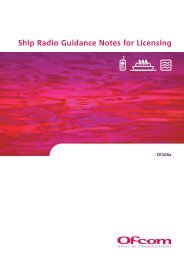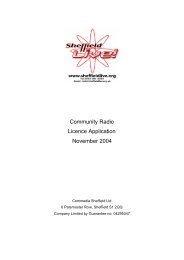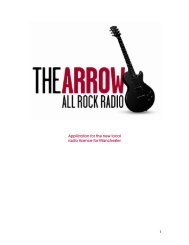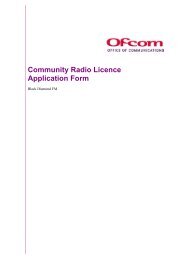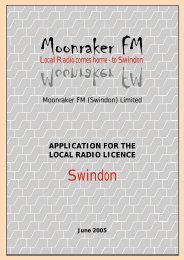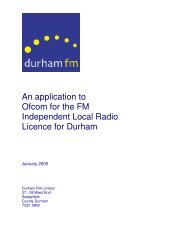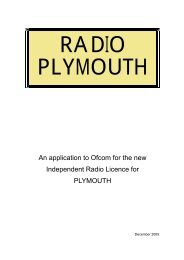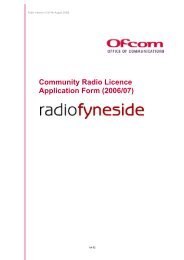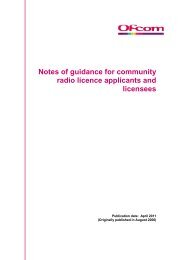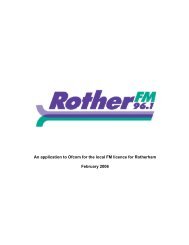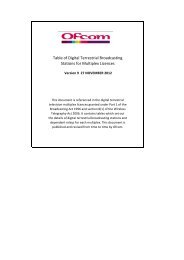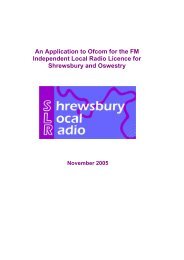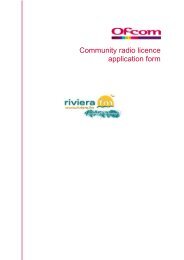Kismat FM - Ofcom Licensing
Kismat FM - Ofcom Licensing
Kismat FM - Ofcom Licensing
Create successful ePaper yourself
Turn your PDF publications into a flip-book with our unique Google optimized e-Paper software.
<strong>Kismat</strong><br />
Section 105(D): Evidence Of Local Demand & Support Radio<br />
We were also pleased to note that two-thirds of non-regular listeners said they would be likely to listen to<br />
<strong>Kismat</strong>, with 20% very likely to listen.<br />
Finally, those likely to listen to <strong>Kismat</strong> were asked how frequently they felt that might be. Again, responses showed<br />
strong support for <strong>Kismat</strong> giving further confidence to our plans.<br />
37% of likely listeners said they would listen to <strong>Kismat</strong> every day, with a further 16% on 5 to 6 days a week<br />
and 24% 3 to 4 days a week. Overall, three quarters of those likely to listen would do so on a regular basis<br />
of 3 or more days a week.<br />
Respondents over 35 were again those most likely to listen every day to <strong>Kismat</strong>.<br />
FOCUS GROUPS<br />
The following summary is taken from the executive overview in the report of the Focus Groups prepared for<br />
Facts International, together with quotes also taken from the report.<br />
Radio Listening<br />
Respondents listened to a mix of Asian and English-language radio stations. Those with more fluent English<br />
tended to listen to non-Asian stations for their music content as well.<br />
“I came from Pakistan: I am not familiar with English music, and I like to listen to my own Asian music.” (female)<br />
Among younger listeners, the most frequently listened to English stations were Galaxy, Key and Radio 1.<br />
Asian Sound<br />
Asian Sound was the most listened to Asian station for many respondents, especially those with less-fluent English.<br />
They appreciated both hearing ‘their music’, and the focus on things Asian. Language-specific broadcasting slots<br />
were well-accepted, and possibly helped to cement bonds with those listeners. There was also some listening to<br />
Sunrise and, to a lesser extent, BBC Asian Network and Club Asia on Sky digital.<br />
Those who were less involved with Asian Sound, were more critical of its unprofessional presenting<br />
standards, narrow religious programming and of the imperfect reception.<br />
“They’re not very professional: there will be a lot of gaps; the newsreader forgets his lines. - He couldn’t<br />
read the paper! I go on at my mum & dad, saying ‘switch it off’.” (male, in his 30s)<br />
Reactions to the content of Asian Sound among the less-involved were varied: there was no clear dismissal<br />
of the station as ‘not for me’ from either older or younger respondents. If anything, rejection seemed to be<br />
linked with a high level of English, meaning that it was easy to switch to a great variety of other radio<br />
stations to satisfy personal inclinations.<br />
Evidence of Demand<br />
FREQUENCY OF LIKELY LISTENING - % Likely Listeners<br />
All M F 15-24 25-34 35-44 45-54 55-64 65+<br />
Every Day 37% 40% 33% 28% 34% 39% 38% 45% 57%<br />
5-6 Days/Week 16% 13% 18% 19% 11% 14% 14% 9% 43%<br />
3-4 Days/Week 24% 25% 23% 33% 22% 19% 16% 45% -<br />
1-2 Days/Week 19% 17% 20% 17% 27% 20% 21% - -<br />
<strong>Kismat</strong> Radio/Facts International January 2005<br />
Section 105 (D) : Page 5




